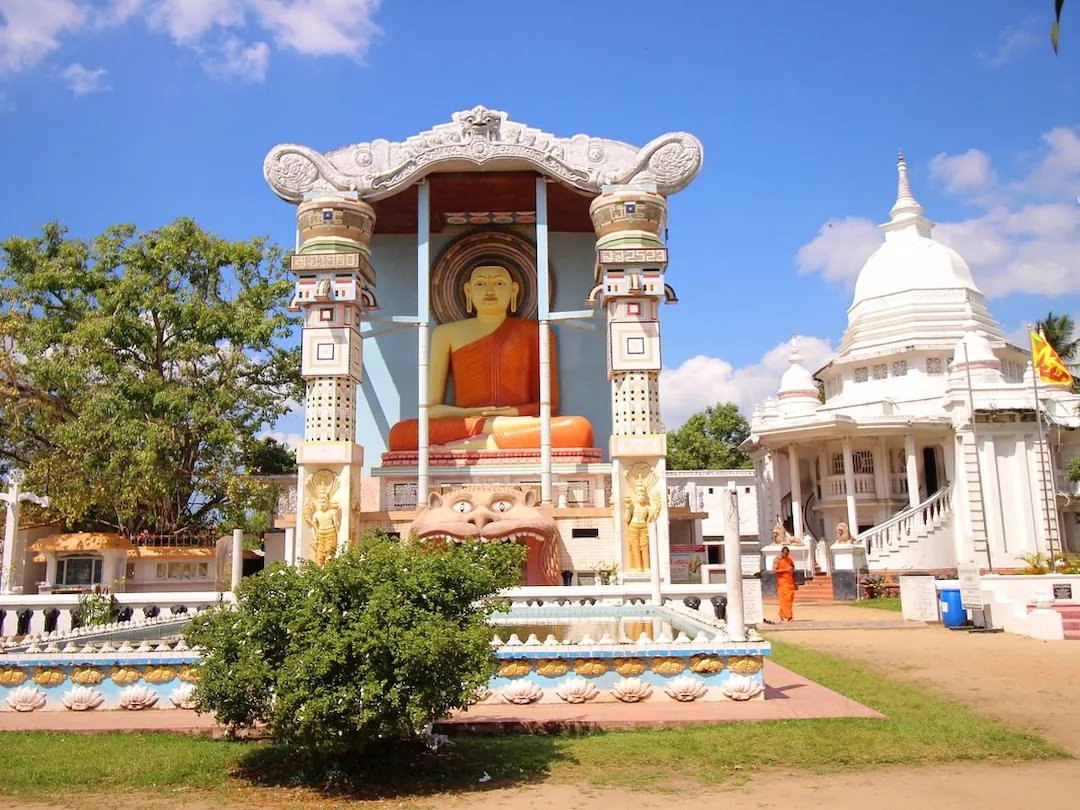Negombo, is one of the most popular tourist attracted city in Sri Lanka, is often called “Little Rome” because of its strong Catholic presence. Basically over 90% of the population is Catholic. We talked about this in our previous article, “N. S. Godamanna: The Forgotten Michelangelo of Negombo.”

Yet, Negombo also has deep Buddhist roots too. Angurukaramulla Temple, also known as Bodhirajarama Maha Viharaya, is a well-known Buddhist temple in Negombo and a popular religious center. It is one of those places that holds Buddhist roots in Negombo.
Personally, I’d recommend Angurukaramulla Temple as a spiritual haven for both locals and visitors. It’s also a must-visit place in Negombo, especially if you’re a first-time visitor; you may ask why, so let me explain.
The Religious Diversity of Negombo
When people talk about Negombo, its Catholic identity is the first thing that usually comes up. It’s no surprise since over 90% of the city’s population follows Catholicism. The skyline is dotted with steeples from more than 50 churches and shrines scattered across the municipality. Walking through Negombo, you can’t miss the influence of the faith. Many of Sri Lanka’s Catholic Bishops have come from this region, and even the country’s only Cardinal traces his roots back to this stronghold of faith. For locals, the Catholic Church isn’t just a place of worship; it’s actually the center point of the community.
Growing up here, you’d constantly be surrounded by the sound of church bells, the sight of processions, and a sense of togetherness that seems to unite the entire city.
Buddhist Roots in Negombo
Negombo also has a deep Buddhist history. Buddhists may make up less than 10% of the population, but their devotion and enthusiasm for their faith are just as remarkable. You can really feel this when you visit temples like the Angurukaramulla. I personally believe there’s something special about the energy in these places.
Brahmachari Walisingha Harischandra, one of the most prominent figures in Sri Lanka’s Buddhist heritage, was born in Negombo’s Thimbirigaskatuwa. He wasn’t just a religious leader but also a patriot who fought to preserve the Buddhist culture during colonial times. Harischandra Vidyalaya, one of the city’s most respected schools, is named in his honor as a reminder of the city’s solid Buddhist legacy.
The Historical Significance of Angurukaramulla Temple
Angurukaramulla Temple, also known as Bodhirajarama Maha Viharaya, located in Negombo, the temple has a history of more than 300 years. It was constructed during the reign of King Devanampiyatissa, one of Sri Lanka’s early rulers, who reigned in the 3rd century BCE. The fact that a structure from this era still stands is incredible in itself.
One of the first things you’ll notice as you approach Angurukaramulla Temple is the massive 6-meter-tall Buddha statue that dominates the landscape. Not only that there’s a dragon’s head right at the base of the statue, marking the entrance to the Buduge (shrine room). The dragon, with its open jaws, is believed to ward off evil spirits, offering protection to the temple and its visitors.
The Pilima Ge, another key feature of the temple, houses life-sized statues of Sinhala kings from Vijaya, the island’s first recorded king, to Sri Wickrema Rajasinghe, the last monarch before British colonization. Another striking feature is the temple’s 48-foot-long reclining Buddha statue; this statue is considered one of the longest reclining Buddha statues in Sri Lanka. This symbolizes the Buddha’s final moments of peace and enlightenment.
Bhodhirajarama Viharaya, Abhayasekeraramaya
Bhodhirajarama Viharaya, often called Angurukaramulla Temple, is an essential stop for anyone passing through Negombo, especially Buddhist pilgrims.
Just a stone’s throw from Bhodhirajarama Viharaya stands another significant cultural landmark: Abhayasekeraramaya Temple. While its spiritual importance is unquestionable, what truly distinguishes this temple is its role as a beacon of education.
After the passing of Madampe Aggawamsa Tissa Nayaka Thera in 1961, the temple saw a remarkable transformation under the leadership of Meegomuwe Jinwamsa Thera. He not only upheld the temple’s religious functions but also broadened its scope to include education in Pali and Sanskrit, a testament to his vision and dedication.
These ancient languages, Pali and Sanskrit, are not only fundamental to Buddhist teachings but also integral to Sri Lanka’s cultural and intellectual history. What’s particularly fascinating is that the temple’s educational programs attracted a diverse range of students, including both Buddhists and non-Buddhists, and even members of the Catholic clergy.
A Library Steeped in History
One of the hidden gems of the Angurukaramulla Temple complex is its 300-year-old library. Although the library no longer functions in the same way it once did, its historical significance remains intact. Over the centuries, it was a repository for sacred scriptures and scholarly works that helped preserve the region’s intellectual heritage. In a time when knowledge was largely passed down through oral traditions or handwritten texts, this library stood as a vital center for learning and cultural preservation. Even though many of its original works have been lost or relocated, walking through its halls gives you a sense of the intellectual legacy it represents.
How to Reach Angurukaramulla Temple
Getting to Angurukaramulla Temple is pretty straightforward, especially if you’re coming from Katunayake Airport. The temple is located about 10 kilometers away from the airport, which translates to roughly a 15-minute ride, depending on traffic. You’ve got a few transportation options to choose from. If you’re the type who likes the convenience of modern technology, Uber is available and will get you there with ease. For those who want a more local experience, hopping into a tuk-tuk is always an exciting choice. Tuk-tuks are not only affordable, but they add a fun, authentic Sri Lankan touch to your journey. You can also choose to grab an airport taxi right after you land; the service is reliable, and they’ll drop you off at the temple in no time. If you want more information, you can read our Ultimate Transportation Guide to Negombo article.
Dress Code and Etiquette
When visiting Angurukaramulla Temple, it’s important to respect the cultural and religious customs. Like many sacred sites, the temple has a specific dress code that all visitors need to follow. Light-colored clothing is recommended, with white being the preferred choice, as it symbolizes purity in Buddhist tradition. Make sure your clothes cover both your shoulders and knees—modesty is key here. It’s a simple gesture, but it shows your respect for the spiritual significance of the temple. One other thing to keep in mind is that you’ll need to remove your shoes before entering the temple grounds. This is a common practice in Buddhist temples across Sri Lanka, and it adds to the sense of humility and reverence. So, make sure you’re wearing comfortable footwear that’s easy to slip on and off.
